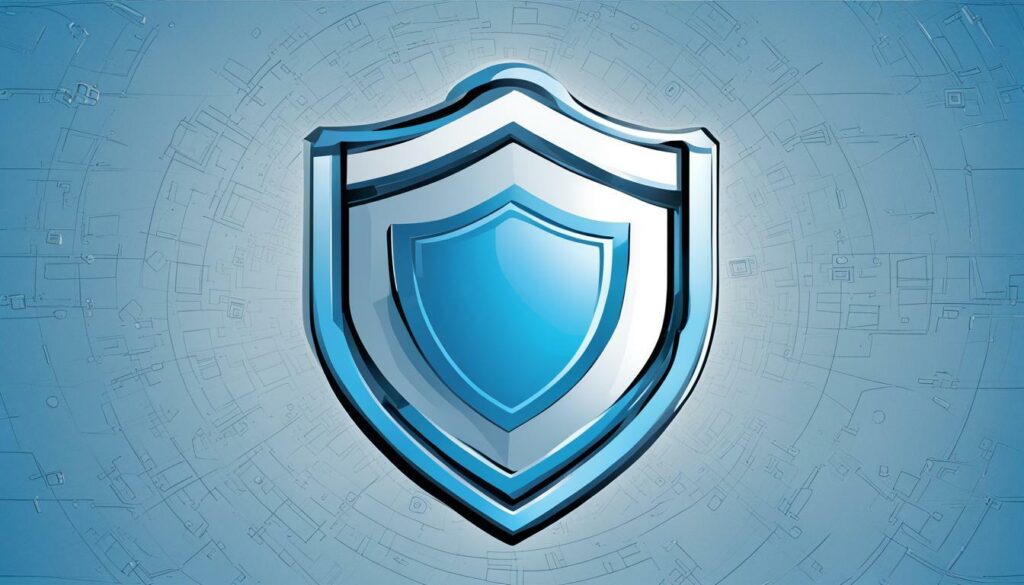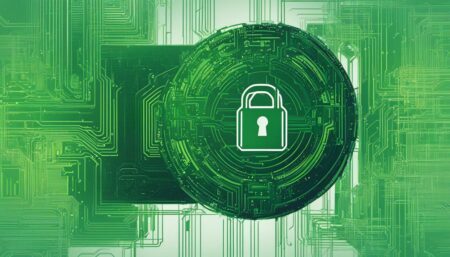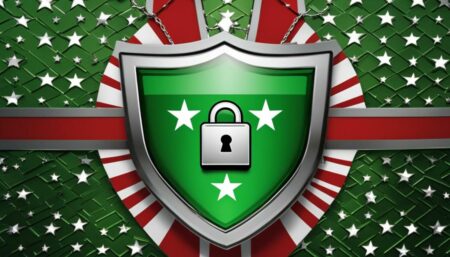If you own a website, you understand the importance of keeping it secure. A Squarespace SSL certificate is essential in safeguarding your online platform from cyber threats. With data breaches and hacking attempts on the rise, protecting your website has never been more critical. By investing in a Squarespace SSL certificate, you not only safeguard your site but also gain your users’ trust.
Key Takeaways:
- Squarespace SSL certificate secures your online platform from cyber threats.
- Protecting your website is essential in safeguarding the data of your users.
- An SSL certificate enhances the trust between you and your users.
Enhance Website Security with Squarespace SSL Certificate
As a website owner, you have a responsibility to ensure the safety of your users’ sensitive information. With the rising number of cyber threats, it is becoming increasingly important to secure your website with a Squarespace SSL certificate.
When you secure your website with Squarespace SSL, you enable secure encryption that protects your users’ data from prying eyes. This means that personal information, such as credit card numbers or passwords, is encrypted and kept safe from unauthorized access.
Almost all major web browsers now clearly indicate whether a website is secure or insecure, making it important to secure your website to ensure your users’ trust and confidence. The last thing you want is to lose potential customers because of a lack of security.
Why Squarespace SSL?
Squarespace SSL offers advanced security features that ensure your website is secure from end-to-end. With SSL enabled, your users’ data is encrypted both at rest and in transit, ensuring peace of mind that their information is safe. Squarespace SSL is easy to set up and is affordable, making it a practical choice for businesses of all sizes.
If you want to enhance your website security and gain your users’ trust, secure your website with Squarespace SSL today.
Setting up Squarespace SSL: A Step-by-Step Guide
Setting up a Squarespace SSL certificate is an important step towards securing your website and protecting user data. Here’s a step-by-step guide to help you through the process:
Step 1: Purchase an SSL Certificate
The first step towards setting up a Squarespace SSL certificate is to purchase one. You can purchase a certificate directly from Squarespace or a third-party SSL provider.
Step 2: Verify Your Domain
Once you have purchased an SSL certificate, the next step is to verify your domain. Squarespace provides an easy-to-use validation tool that allows you to verify your domain in just a few clicks.
Step 3: Configure Your SSL Settings
After your domain is verified, you can configure your SSL settings. Squarespace provides two options for SSL configuration – “Secure (recommended)” and “Flexible”. We recommend choosing the “Secure” option for added security and improved SEO rankings.
Step 4: Install Your SSL Certificate
With your SSL settings configured, the next step is to install your SSL certificate. Squarespace provides step-by-step instructions on how to install your certificate, making the process quick and easy.
Step 5: Verify Your SSL Configuration
After installing your SSL certificate, it’s important to verify your SSL configuration to ensure everything is working properly. Squarespace provides a handy SSL checker tool that allows you to verify your SSL configuration in just a few clicks.
Setting up a Squarespace SSL certificate may seem daunting at first, but with these easy-to-follow steps, you’ll have your SSL certificate up and running in no time!
Understanding Squarespace SSL Encryption
SSL encryption is a security protocol that encrypts data sent between a website and its visitors, ensuring that sensitive information like personal details, login credentials, and payment data are protected from hackers and cybercriminals.
Squarespace SSL certificates use industry-standard 256-bit encryption to secure data transmitted from visitors to your website. This encryption ensures that any data exchanged over the internet between Squarespace and visitors remains private and cannot be intercepted or tampered with by unauthorized users. Squarespace SSL certificates also comply with the Payment Card Industry Data Security Standard (PCI DSS), further ensuring the security of online transactions conducted on your website.
SSL encryption is essential for building trust with your visitors and keeping their information secure. It can also boost your website’s SEO rankings, as Google favors secure websites with HTTPS encryption. With a Squarespace SSL certificate, you can enjoy the peace of mind that comes with knowing your website and your visitors are protected.
Squarespace SSL Certificate Cost: Affordable Security
Securing your website with an SSL certificate is a must-do these days. Fortunately, Squarespace offers SSL certificates at an affordable cost. Whether you’re a small business or an individual, you can secure your website and build trust with your users without breaking the bank.
With Squarespace’s SSL certificate, you can enjoy the benefits of HTTPS encryption and keep your user’s data safe. Having an SSL certificate can also improve your SEO rankings and show users that your website is secure and reliable.
| SSL Certificate Type | Cost per Year |
|---|---|
| Basic SSL | $20 |
| Wildcard SSL | $200 |
For just $20 a year, you can secure your website with a Basic SSL certificate. This certificate secures a single domain and comes with a warranty of up to $10,000. If you have multiple domains or subdomains, you may want to opt for the Wildcard SSL certificate, which costs $200 a year and secures unlimited subdomains.
When you consider the benefits of having an SSL certificate, the cost is a small price to pay for the peace of mind that comes with knowing your website and user’s data are secure. Don’t let security concerns hold your website back – get a Squarespace SSL certificate today.
How to Install SSL Certificate on Squarespace
Are you ready to secure your Squarespace website with an SSL certificate? Follow these step-by-step instructions to get started.
Step 1: Purchase an SSL Certificate
Before you can install an SSL certificate on Squarespace, you must purchase one. Squarespace offers SSL certificates for $20 per year or $70 for four years. Once you have purchased your certificate, it will be ready to install.
Step 2: Add SSL to Your Squarespace Site
To add SSL to your Squarespace site, follow these instructions:
- Log in to your Squarespace account and navigate to the ‘Settings’ menu.
- Click ‘Advanced’ and then select ‘SSL’.
- Toggle the switch to ‘Enabled’ and select the SSL certificate you purchased.
It may take up to 72 hours for your SSL certificate to be fully installed and active on your site.
Step 3: Redirect Your Site to HTTPS
Once you have enabled SSL on your Squarespace site, you will need to set up a redirect from HTTP to HTTPS to ensure that your site loads securely. To do this:
- Return to the ‘Settings’ menu in your Squarespace account.
- Select ‘Website’ and then choose ‘Domains’.
- Click ‘Advanced Settings’ and toggle the switch to redirect your site to HTTPS.
It’s important to note that any internal links within your Squarespace site must also be updated to use HTTPS to avoid any security warnings.
Step 4: Test Your SSL Certificate
Once you have completed the installation process, it’s always a good idea to test your SSL certificate to make sure it’s working properly. You can use online tools such as SSL Labs or Why No Padlock to test your site’s SSL configuration.
By following these simple steps, you can install an SSL certificate on your Squarespace website and enjoy the peace of mind that comes with secure encryption.
Enjoy the Benefits of Squarespace SSL
Securing your Squarespace website with an SSL certificate can have numerous benefits for you and your users. By encrypting sensitive data, you can protect your users from potential cyber attacks that can lead to data breaches.
Aside from security benefits, having an SSL certificate can also improve your search engine rankings. Google rewards websites with SSL certificates by ranking them higher in search results.
Additionally, customers are more likely to trust websites that have SSL certificates. Users are aware of the risks associated with sharing sensitive information on websites that are not secure, and having an SSL certificate can put their minds at ease.
Lastly, SSL certificates enable secure online transactions. Whether you’re selling products or services, having an SSL certificate ensures that your transactions are protected from potential hacks or fraud attempts.
With all of these benefits in mind, it’s clear that securing your website with a Squarespace SSL certificate is a wise decision. Not only does it provide peace of mind for both you and your users, but it can also improve your website’s performance and credibility.
Squarespace SSL Requirements: What You Need to Know
If you’re considering securing your Squarespace website with an SSL certificate, it’s important to understand the requirements for implementation. Here’s what you need to know:
| Compatibility | Squarespace SSL certificates are compatible with all modern web browsers and devices. However, older browsers or devices may not support the latest encryption standards. It’s essential to ensure your website is accessible to all users. |
|---|---|
| Domain validation | Squarespace requires domain validation to ensure that the SSL certificate is being requested by the legitimate website owner. This process involves verifying ownership of the domain through email, DNS, or other methods. |
| Technical specifications | Squarespace SSL certificates require the use of HTTPS on all pages of the website. Additionally, the certificate must meet certain technical specifications for encryption strength and key size. |
By meeting these requirements, you can ensure that your Squarespace website is secure and accessible to all users. If you have any questions or concerns about implementing an SSL certificate, Squarespace offers helpful resources and support.
Troubleshooting Squarespace SSL Issues
If you’re having trouble with your Squarespace SSL certificate, don’t worry. There are a few common issues that can arise, but they’re typically easy to fix. Here are some tips for troubleshooting your Squarespace SSL:
- Make sure your SSL certificate is installed correctly. Check the expiration date and confirm that the certificate covers all of your site’s pages and subdomains.
- Verify that your domain is validated. If your domain is not validated, SSL encryption won’t work.
- Ensure your browser is up-to-date. An outdated browser may not recognize your SSL certificate.
- Check firewall and security settings. Sometimes, security settings can prevent your SSL certificate from working correctly.
- If you have multiple SSL certificates installed, ensure they are not conflicting with each other.
If none of these steps resolves your issue, Squarespace offers support resources to help you troubleshoot. Their support team is available 24/7 to assist you with any issues you may encounter.
Conclusion
Protecting your website and its users is of utmost importance. By implementing a Squarespace SSL certificate, you can enhance your website’s security and earn your users’ trust.
With step-by-step guides available, setting up your Squarespace SSL certificate is easier than you think. The affordable cost and various benefits associated with a Squarespace SSL certificate make it a wise investment for your website.
Don’t hesitate to troubleshoot any issues that may arise – resources and support are available to ensure a smooth installation process.
Secure your website today with Squarespace SSL – your users, your business, and your peace of mind will thank you.
FAQ
Q: What is a Squarespace SSL certificate?
A: A Squarespace SSL certificate is a digital certificate that ensures secure encryption of data transmitted between a website and its users. It helps protect sensitive information and establish trust with visitors.
Q: Why is securing my website with a Squarespace SSL certificate important?
A: Securing your website with a Squarespace SSL certificate is important because it protects user data, enhances website security, and boosts customer trust. It also improves search engine rankings and ensures secure online transactions.
Q: How do I set up a Squarespace SSL certificate?
A: Setting up a Squarespace SSL certificate is a simple process. You can follow our step-by-step guide, which includes instructions, screenshots, and helpful tips to help you through the setup process.
Q: What is SSL encryption and how does it work with Squarespace websites?
A: SSL encryption is the process of encrypting data transmitted between a website and its users to ensure privacy and security. Squarespace websites utilize SSL encryption to protect user information and establish a secure connection.
Q: How much does a Squarespace SSL certificate cost?
A: Squarespace SSL certificates are affordable and offer different pricing options to suit your needs. The cost varies depending on the duration of the certificate and any additional services you may require.
Q: How do I install an SSL certificate on Squarespace?
A: Installing an SSL certificate on Squarespace is a straightforward process. Our step-by-step guide provides detailed instructions for different scenarios and can help you troubleshoot any common issues that may arise.
Q: What are the benefits of having a Squarespace SSL certificate?
A: Having a Squarespace SSL certificate offers numerous benefits, including improved SEO rankings, increased user trust, and secure online transactions. It helps protect sensitive information and enhances the overall security of your website.
Q: What are the requirements for implementing a Squarespace SSL certificate?
A: Implementing a Squarespace SSL certificate requires compatibility with your website, domain validation to ensure ownership, and adherence to technical specifications. Understanding these requirements is crucial for a successful implementation.
Q: What should I do if I encounter issues with my Squarespace SSL certificate?
A: If you encounter issues with your Squarespace SSL certificate, our troubleshooting section provides solutions and tips to help you resolve common issues. Additionally, there are resources available for further assistance.





